I have lived nearly all my adult life within a few miles of the Mississippi River. I’ve ridden my bike for miles along the levees, and when the water is low, I’ve ridden on the riverbank itself. I’ve paddled along the diversion channels and creeks flowing into the river. I’ve watched hundreds of sunrises, sunsets, and full moons from the riverbank. I also have a healthy respect for the power of the river. I have seen firsthand the devastation of many floods and their aftermath, and I have heard all the warnings about how unsafe the river can be.
And yet, I am still drawn to it. So when I was offered the opportunity to tag along on the French Corridor Expedition hosted by Big Muddy Adventures (BMA) last fall, I jumped at the chance. When I learned an award-winning chef would prepare all our meals, the adventure couldn’t get here fast enough.
The French Corridor Expedition is a three-day, two-night paddling adventure on the Mississippi River. The late September float typically starts in downtown St. Louis and ends in historic Ste. Genevieve, Missouri. Not only do participants get to experience the beauty of the river, but they also get to enjoy “campfire gourmet” meals prepared by chef Josh Galliano, one of the Midwest’s best chefs and a veteran of the St. Louis dining scene. The entire experience highlights and honors the history, food, and culture of those who traveled these spaces hundreds of years before us. What follows is the story of my trip.
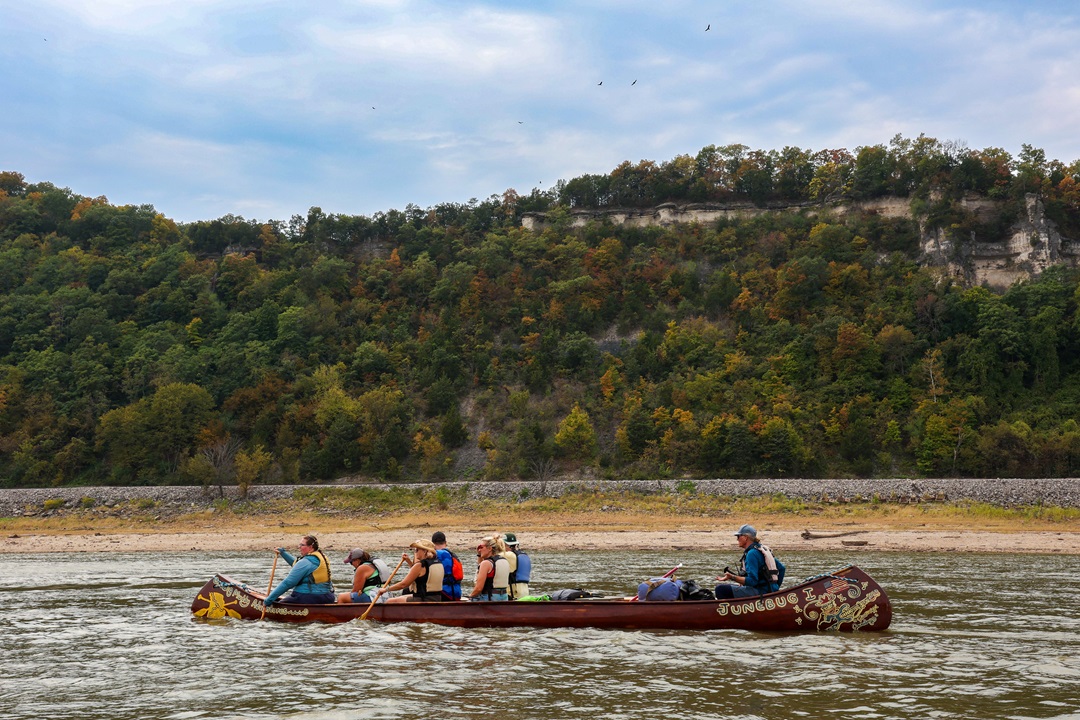
Paddling down the Mississippi River. (Natalie Rolwes)
Day 1: Crystal City to Fort de Chartres
Not quite sure what to expect for this adventure, I took a minimalist approach to packing and brought only what I could fit in my largest dry bag: my bikepacking tent, camp chair, blanket and sleeping pad, two changes of clothes, a few toiletries, water bottle, phone charger, and flashlight.
We met at the BMA warehouse in Midtown St. Louis, and I realized my first mistake as I watched participants stuff comforters and full-size pillows into the provided XXL dry bags. While we were not quite at the level of glamping, comfort was something I hadn’t needed to scrimp on. As we waited for everyone to arrive, we were fitted with PFDs (personal flotation devices) and marked our gear. We also began to adjust to “river time,” letting go of the rigidity of our regularly scheduled lives and accepting the fluidity of the days to come.
The river was especially low, which meant St. Louis boat traffic was more compressed than usual, so we shuttled down to Crystal City to put in. While our guides prepped the canoes for our journey, Galliano prepared our first meal — an egg foo yung banh mi, more commonly known as a St. Paul sandwich, served with Old Vienna Red Hot Riplets chips, a St. Louis classic. Yum!
After lunch, we were given a quick overview of what to expect on the river and then divided into three groups and selected our canoes. Even with everyone’s gear and all the supplies for three days on the water, there was plenty of room. The 29-foot voyageur canoes could hold up to 14 people each, but on this trip, we had no more than eight people per canoe including the guide.
As we set out, the weather was a perfect mix of sunny and breezy. The paddling itself was not overly challenging. We could rest when we wanted and still make progress. The canoes were quite stable and, with the weight of the gear distributed evenly throughout the canoes, there was little movement when people shifted in their seats.
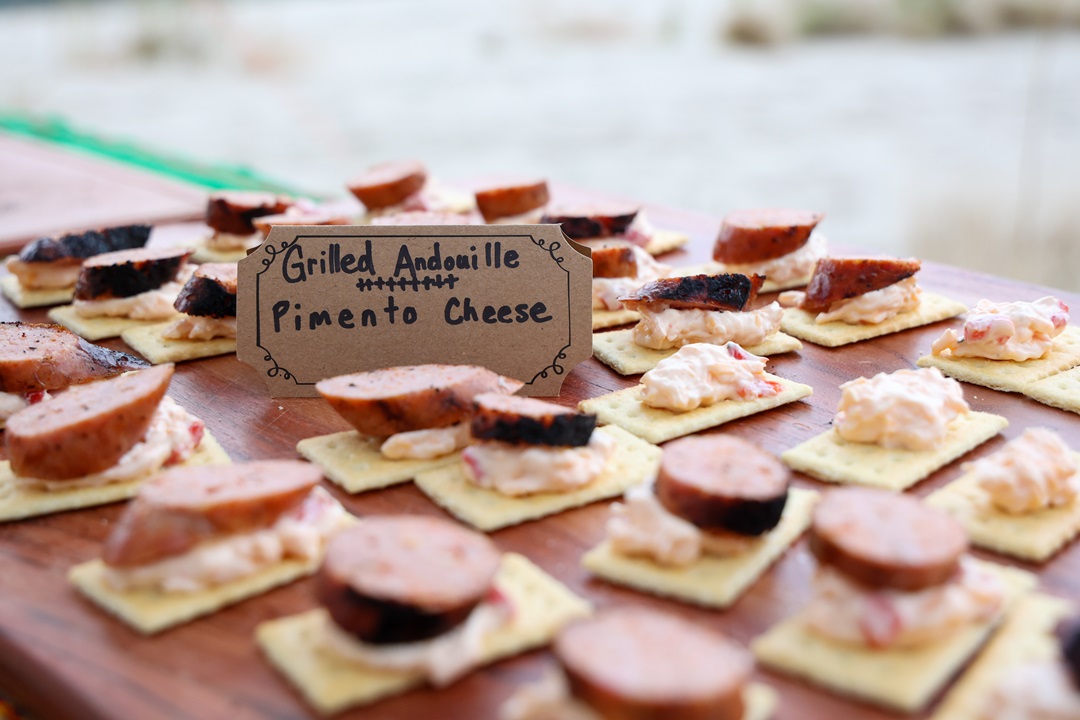
Appetizers on the French Corridor Expedition. (Natalie Rolwes)
Our guides — “Big Muddy” Mike Clark, Tanner Aljets, and Mark “Malko” Malkowicz — kept us on track and communicated if we needed to adjust our paddling. Even though they appeared to be relaxed and relishing their time on the water, they were paying close attention to boat traffic and watching the movement of the river. They were also in regular communication with each other.
There was plenty of opportunity to take in the sights from the perspective of the Mississippi and reflect on the river’s role in shaping the landscapes, the communities, and the culture of the region. As an English professor who has frequently taught Mark Twain’s novels, I couldn’t help thinking about Huck Finn’s journey along the river and wondering how much the waterway has changed over the years.
We paddled just over 15 miles and stopped near Fort de Chartres, a French military construction built in the 1700s. The crew secured the canoes, and we unloaded our gear and began setting up our tents along the sandy beach. Galliano and his wife/sous chef Audra set up their kitchen space and began prepping for food service. We all contributed to the pile of driftwood, which kept the fire going all night.
To keep people satisfied after several hours of paddling, Galliano set out grilled andouille and pimento cheese on crackers and then went to work on dinner.
Galliano said when he and Mike first started discussing the possibility of the French Corridor adventure, Mike compared it to the voyages of Lewis and Clark, and this was the inspiration for the meals throughout the event. According to Galliano, the men on these voyages were “the biggest meat eaters you’ve heard of. They hunted and needed to consume so many calories. They wanted to have something gamey that they could roast or cook it down and stew it.” The chef wanted to honor that, so for the first night’s dinner, he prepared tomato braised venison, using deer his father-in-law had killed, with gnocchetti and garnished with gremolata.
We gathered around the fire to enjoy our meal and get to know each other a bit more. Our group came from all walks of life, ranging from a software engineer to a stone mason to a traveling nurse. Several in the group had done at least one trip with BMA before this, and for one woman, this expedition was her 77th BMA outing. (Yes, really.)
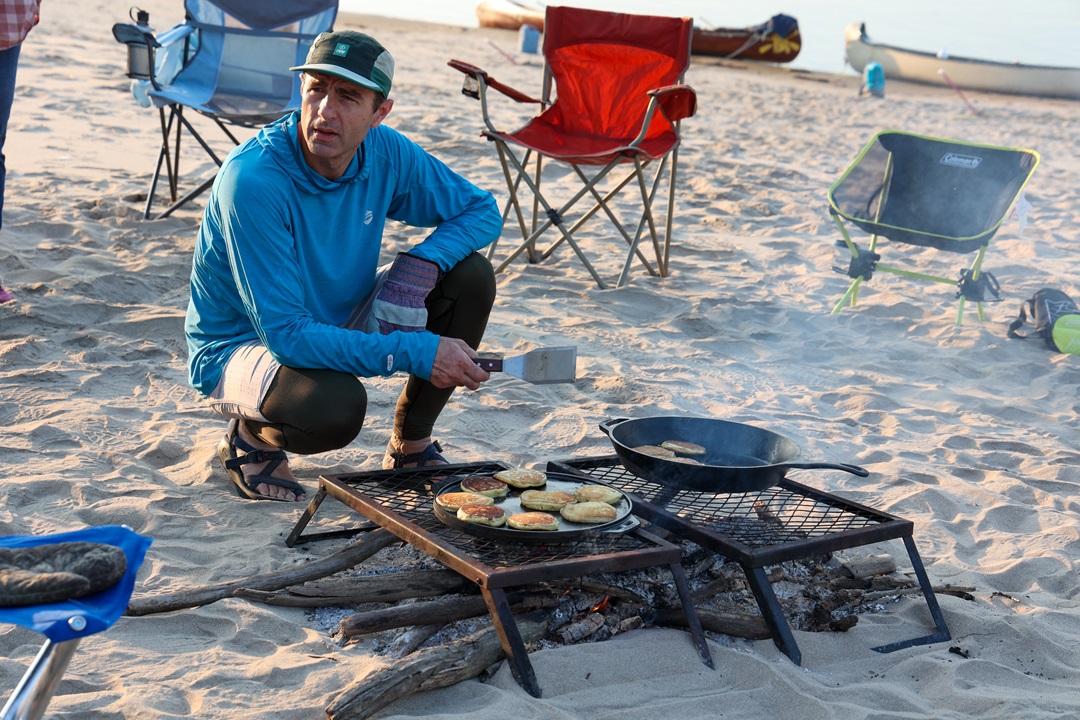
Chef Galliano works the grill. (Natalie Rolwes)
Day 2: Onward to Moro Island
We had a leisurely morning with plenty of time for coffee and sitting quietly, observing the hypnotic rhythms of the river. For breakfast, we ate foraged eggs and pawpaw pancakes with elderberry syrup, another meal paying homage to explorers and the people who previously inhabited this land. After breakfast, we packed our gear, loaded the canoes, and took a short paddle downstream.
We pulled off at a beach near the trail to Fort de Chartres and hiked 1.75 miles to where portions of the original foundation for the stronghold’s walls still exist. The fort was built in 1753 by the French during their 18th-century colonization of the Illinois Country and was later occupied by the British after France ceded much of its territory to Great Britain. We toured the grounds and the small museum, learning about some of the key figures in the history of the fort and the surrounding communities, and then trekked back to the beach.
As Galliano prepped for our next meal, I became more and more impressed with his jenga-style level of packing. According to Galliano, “The most important thing is the planning. The extra equipment needed has to be bare bones enough so there isn’t too much weight. Whatever we do, we have to ensure that we are going to eat, and it is executed in a timely manner.” Galliano’s goal was to ensure that people are well-fed without having to worry about anything.
For lunch, he prepared brathering, which is fried and pickled catfish, a mixed green salad with pumpkin seed vinaigrette, and sweet cornbread.
BMA practices “pack in, pack out,” so while the crew washed dishes and cleaned up, a few folks waded or swam in the river and the rest of us enjoyed the warmth of the sun and sand. Soon enough it was time to load the canoes and head back out on the river. We were encouraged to change seats or change canoes, partly to spend time with new people and partly to experience the river from a different vessel. Each boat “feels” slightly different, both in how it sits on the water and how it responds to the push and pull of the river.
We paddled for another 8 miles and then stopped at Moro Island for the night. Galliano set out olive oil ciabatta with muhammara (a spicy dip) to tide us over until dinner. After I set up my tent, I explored the island, checking out the flowers and plants that grew in patches. I marveled at the patterns of tracks in the sand left by insects and birds. These quiet moments far away from the busyness and noise of daily life provided a wonderful mental and physical reset.
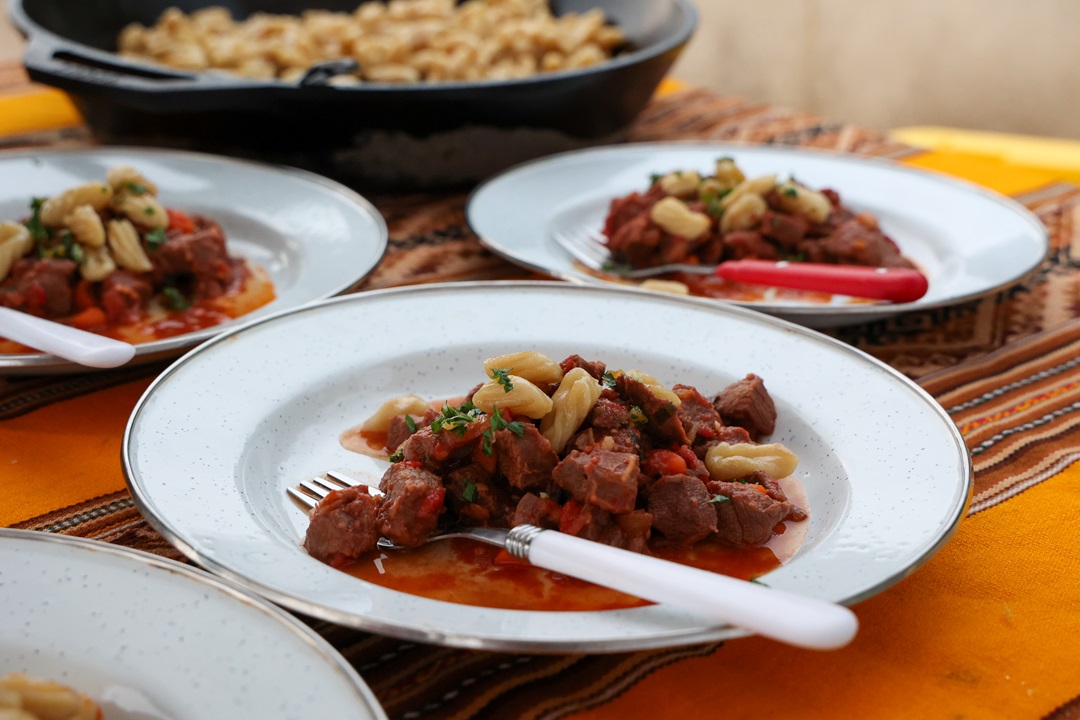
One of Galliano’s “campfire gourmet” meals. (Natalie Rolwes)
I rejoined the group and observed that, by this point in the trip, our group had become more cohesive, evidenced by the circle of chairs around the fire and the lively conversations. Mike acknowledged this, stating, “I am forever blown away by what happens when people who don’t know each other come out here, and these boats, and these guides, get you in a position to do what we are doing.”
Mike and I talked about previous trips — this year was the fourth iteration of the French Corridor Expedition — and people he had met on the river. He and Tanner shared a few stories about David Miller, author of The Complete Paddler: A Guidebook for Paddling the Missouri River from the Headwaters to St. Louis, Missouri. A few minutes later, we noticed a kayaker coming toward our encampment. To everyone’s surprise, it was none other than David Miller!
Galliano was finishing up dinner, so we invited David to join us. The chef had prepared turkey roulade and risotto, which, he said, harkens back to when “we weren’t the first people around here — turkey was a great source of protein and utilizes the natural resources we have.”
Once everyone was served and we dug into our meal, Mike commented, “The best compliment is when the food is served and no one talks.” And then we continued eating in silence.
The conversations resumed once our bellies were full, and David regaled us with stories from adventures throughout his life. In a side conversation I had with Fiona Fordyce, another BMA crew member, she emphasized the importance of fostering the intimate nature of the experience. “Too many people would kill the vibe,” she said.
During a lull in the conversation, Tanner pulled out his copy of Twain’s Life on the Mississippi, which he brings on nearly every trip. With all eyes on him, he read from chapter 13, “A Pilot’s Needs.”
The night began to wind down after a lively game of bocce played with light-up balls and then heaping servings of Galliano’s peach pandowdy.
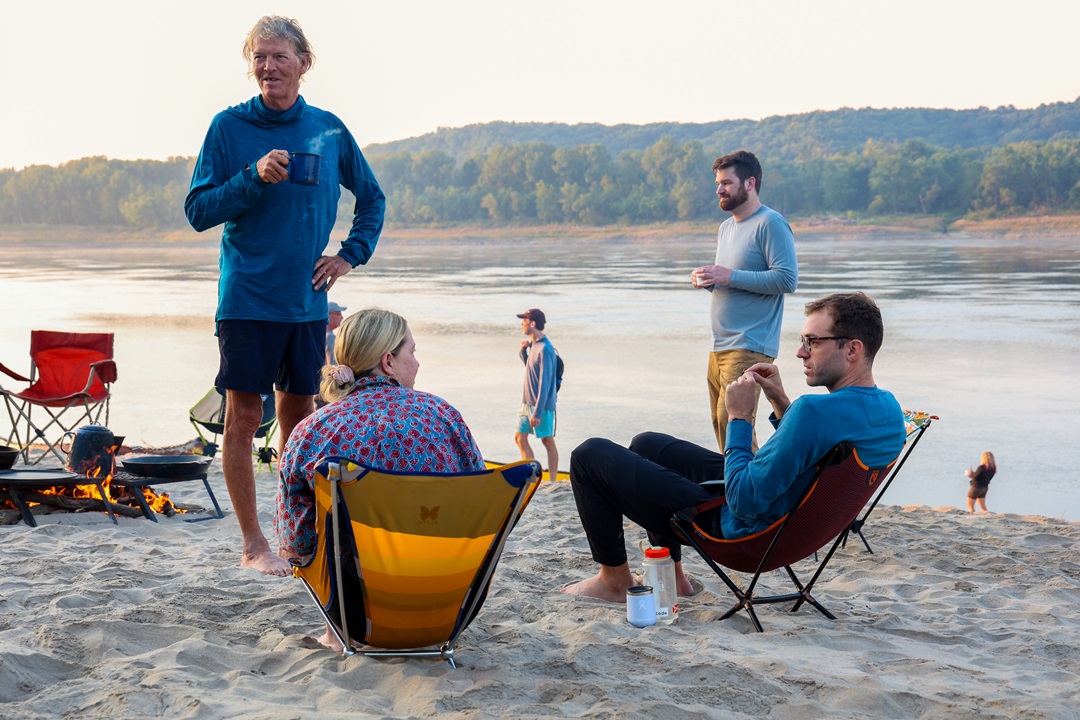
Muddy Mike (left) and crew in the morning. (Natalie Rolwes)
Day 3: The Final Leg
Our last day began slow and easy, much like Day 2. Stacy, a trip participant, stated, “There is just something about looking at the river. It’s mesmerizing.” David replied, “It’s a moment of your own space in space.”
As we settled in for breakfast, Galliano told me that, at the end of the Lewis and Clark expedition, they made boudin blanc, which is white sausage emulsified with milk and bread. William Clark wrote that it was the best boudin he ever had, so, in honor of that, Galliano made boudin, fried eggs, grits, and bread with mixed berry jam. And it was the best boudin I have ever had.
After breakfast, we all moved at a leisurely pace until it was time to load the canoes and start the last leg of the journey. Galliano handed each of us an individually wrapped snack called pemmican, which is dried beef, bone marrow, blueberries, honey, dried cherries, and maple syrup — similar in texture to a soft granola bar. Historically, this snack was an important part of indigenous cuisine in certain parts of North America, mainly because it was a calorie-rich food.
We embarked on the last leg of the journey, which was just over 13 miles to the take-out point. The weather was starting to shift, so we paddled at a faster pace than the previous days, but that doesn’t mean we didn’t have fun. Someone spotted a watermelon floating along, so we paddled over and rescued it. Tanner showed off his gymnast skills by flipping upside-down into a headstand. We shared plenty of laughs and some friendly competition to see who could stay in front of the fleet. Because we had started farther south due to low water, we took out in Chester, Illinois, instead of Ste. Genevieve.
Right as we got to the take-out, it started to rain, so the crew encouraged us to go to the pub just up from the boat launch. Once the gear was loaded and the canoes were secure on the trailers, we headed back to St. Louis.
At BMA headquarters, we said our final goodbyes, and as we parted ways, I kept thinking about Tanner’s reading from Life on the Mississippi and the line that resonated most with me: “Judgment is a matter of brains, and a man must start with a good stock of that article or he will never succeed as a pilot.”
As far as I can tell, the crew at BMA certainly has the brains and judgment to successfully navigate the Mississippi. And I can only imagine what Twain would have written about Galliano’s meals.
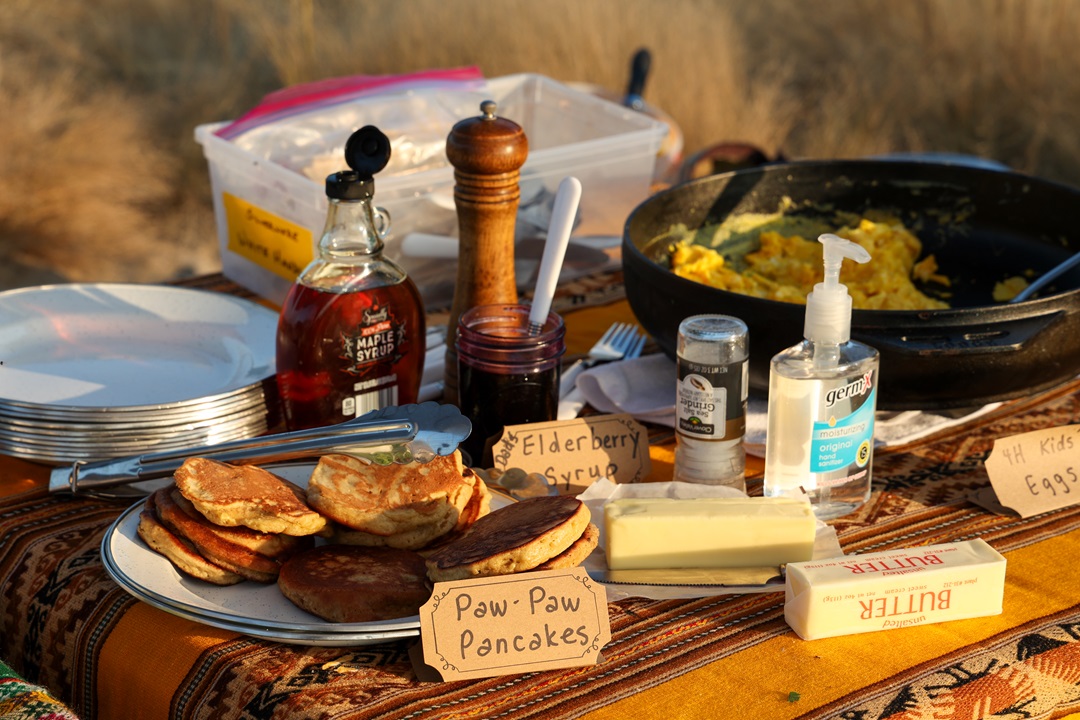
A hearty breakfast on the French Corridor Expedition. (Natalie Rolwes)
***
French Corridor Expedition
What: Three-day, two-night canoe trip
Where: Mississippi River
When: Sep 20-22, 2024
Starts: Downtown St. Louis
Ends: Ste. Genevieve, Missouri
Length: 55 miles
Meals by: Chef Josh Galliano
More info: 2muddy.com/frenchcorridor
Author: Missy Phegley is a frequent contributor to Terrain.
Top image: Paddlers float down the Mississippi River. (Natalie Rolwes)

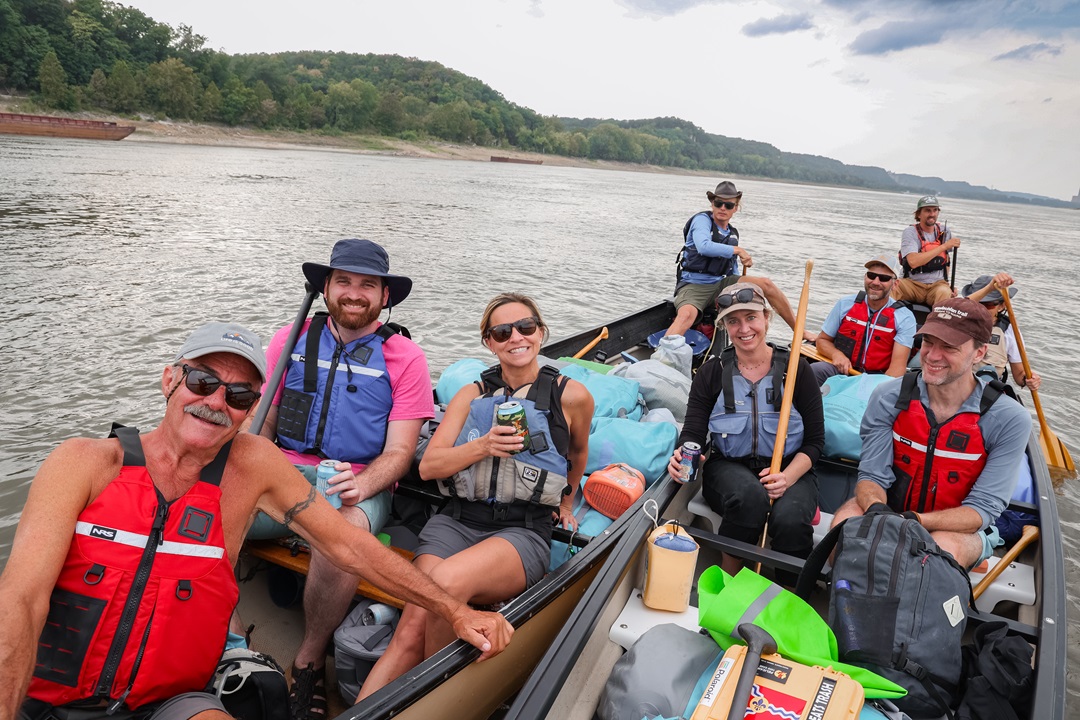
Leave A Comment